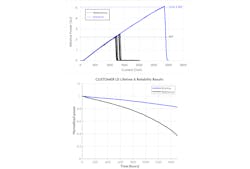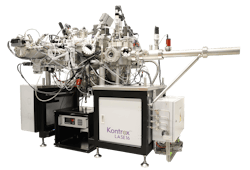Transformative facet passivation for high-power edge-emitting lasers
The growing use of high-power laser diodes for demanding applications underscores the need for highly efficient, reliable, and thermally stable laser facet passivation strategies. These techniques are essential for minimizing optical degradation, mitigating COMD, and ensuring long-term device performance under high-power operation.
But exceedingly high optical power densities at the laser facet pose significant challenges—particularly in the form of COMD.1 This issue is especially pronounced in gallium arsenide-based laser diodes, which are commonly used for telecommunications, medical devices, and material processing.2,3 As data centers scale, indium phosphide (InP)-based diodes for high-speed optical communication are encountering similar reliability challenges that are exacerbated by rising operating temperatures.
The gradual degradation of laser mirror facets during high-power operation is the primary limiting factor in achieving reliable high-power output in edge-emitting lasers. The underlying cause of COMD can often be traced back to the intrinsic properties of the semiconductor surfaces and interfaces, particularly the formation of defective native oxides during the laser bar cleaving process and subsequent exposure to ambient conditions. This air exposure facilitates the formation of poor-quality oxides with a high density of defect states and related surface recombination centers. These factors promote localized optical absorption and thermal runaway, which leads to irreversible damage to the facet. Therefore, mitigating COMD and extending the operational lifetime of high-power laser diodes remain critical challenges that must be overcome to improve device reliability and performance.4
Challenges and practices in high-power laser diodes
Arsenide-based high-power laser diodes (GaAs, InGaAs, and AlGaAs) are integral to industries such as laser cutting, welding, additive manufacturing, and cladding—segments that generate billions in annual revenue. To optimize performance and secure supply chains, many leading companies have turned to vertically integrated diode fabrication.
Today’s laser diodes can achieve lifetimes of tens of thousands of hours under peak conditions, thanks to advanced thermal management systems (submount assemblies and active cooling) and precision optical alignment. But these gains come with high manufacturing and operational costs that necessitate continuous innovation to balance reliability, performance, and affordability.
Efficiency improvements directly reduce heat generation, extend device lifetime, and lower operating costs, which are critical as industrial systems deliver optical powers exceeding several kilowatts. Likewise, boosting brightness (power × beam quality) enables more demanding applications and streamlined system designs. But a persistent bottleneck remains: the laser facet’s susceptibility to the COMD failure mode at extreme power densities.
Addressing these challenges calls for advances in both device design and facet protection strategies, including the development of more robust passivation layers, optimized facet coatings, and novel epitaxial structures. Furthermore, integration of in situ process monitoring and smart feedback systems during manufacturing could enhance the yield and reliability of next-generation high-power laser diodes.
Facet issues and COMD
A typical laser diode fabrication flow involves cleaving individual laser bars from the III-V epi-wafer, followed by antireflection/high reflection (AR/HR) mirror coatings deposition. Although cleaving normally yields an atomically flat, clean, and crystalline semiconductor surface, air exposure rapidly leads to native oxide formation and contamination adsorbtion, introducing atomic-level defects at the facet and related electronic states in the semiconductor band gap. This promotes nonradiative recombination, localized optical absorption, and thermal runaway, which results in irreversible facet damage.5,6
Substantial efforts have been made over the past few decades, both in industry and academia, to address the COMD issue, focusing on two main approaches:6 minimizing oxide formation during cleaving and mirror coatings, and removing oxides and surface defects before applying passivation layers or coatings.
Cleaving in ultrahigh vacuum (UHV) with immediate passivation and/or mirror coating effectively prevents oxidation but suffers from low throughput, technical complexity, and inconsistent process yield.7,8 Air-cleaved bars combined with hydrogen plasma cleaning and molecular beam epitaxy (MBE)-grown zinc selenide (ZnSe) coatings can achieve competitive performance, but ZnSe overgrowth remains prohibitively expensive and technically complex.9,10
Current methods to mitigate COMD
E2 Process. UHV cleaving + amorphous Si deposition stabilizes facets, but uses semi-absorptive layers that require precise thickness control and suffers from low throughput.
ZnSe via MBE. Offers superior lattice matching (e.g., to GaAs) and strong chemical stability, but requires multimillion-dollar MBE system with limited uptime (65 to 70%), extended maintenance, and a large cleanroom footprint.
Hydrogen plasma + ZnSe. Removes native oxides on air-cleaved bars (except Al-containing oxides), but still relies upon costly UHV MBE equipment.
Each approach enhances facet stability, but is limited by high capital expenditures, low scalability, or narrow material compatibility.
Crystalline oxide passivation
In response to a scarcity of cost-effective solutions on the market, Comptek Solutions developed a laser diode facet cleaning and passivation process that eliminates vacuum cleaving and the technical complexity and exorbitant costs associated with ZnSe epitaxy.
Our patented nanoengineering technology—Kontrox—uses a highly controlled oxidation process in UHV to produce high-quality, defect-free native oxides with enduring thermodynamic stability. Unlike disordered, amorphous native oxides, these crystalline III-V surface oxides exhibit distinct lattice superstructures and significantly fewer point defects at the dielectric/semiconductor interface. Applicable across III-V materials, the Kontrox process extends beyond lasers to enable performance benefits in microLEDs, detectors, and RF devices.
Performance improvement and COMD threshold
Laser bars cleaved within ambient air undergo low-pressure hydrogen plasma cleaning followed by our oxidation step in the proprietary UHV equipment. This sequence selectively removes surface states and forms a uniform crystalline oxide layer, which leads to marked gains in facet quality and resilience.
Extensive testing reveals an increase in COMD threshold under both pulsed and continuous-wave operation compared to untreated bars; extended facet stability after passivation, which alleviates time constraints for AR/HR mirror coating and improving production scheduling; and a higher maximum output power, which contributes to increased manufacturing yields and device reliability.
UHV system
To speed industrial adoption, we developed a compact, turnkey UHV system (Kontrox LASE 16) optimized for edge-emitting laser facet passivation. Integrating cleaning, crystalline oxidation, and optional precision facet sealing, it streamlines production with a dual-chamber architecture and automated handling.
Traditional MBE-based passivation demands costly UHV chambers, large cleanroom footprints, and extensive maintenance. In contrast, our system reduces ownership costs by as much as 40% and integrates easily into existing production lines.
Key features such as customizable stacking jigs, optimized plasma uniformity, automated jig transfer, and laser-based bar heating contribute to high process stability, throughput, and efficiency across various edge-emitting laser wavelengths and bar geometries. In situ process monitoring further enables precise control over surface transformations at the atomic level.
Laser facet protection
While laser manufacturers grapple with inefficient and costly coating processes, Comptek Solutions’ crystalline oxide passivation, powered by Kontrox, represents a new approach to laser facet protection. By eliminating vacuum cleaving and the costs of ZnSe epitaxy without compromising performance, the technology unlocks scalable, cost-effective manufacturing of high-power edge-emitting lasers. This innovation paves the way for more reliable, efficient photonic devices for telecommunications, medical, industrial, and emerging markets.
REFERENCES
1. J. W. Tomm, M. Ziegler, M. Hempel, and T. Elsaesser, Laser & Photon. Rev., 5, 3, 422–441 (2011).
2. A. Moserand and E. E. Latta, J. Appl. Phys., 71, 10, 4848–4853 (1992).
3. Y. Song et al., Crystals, 12, 765 (2022).
4. R. W. Lambert, T. Ayling, A. F. Hendry, and J. M. Carson, J. Light W. Technol., 24, 2, 956–961 (2006).
5. J. Robertson, Appl. Phys. Lett., 94, 152104 (2009).
6. L. Lin and J. Robertson, J. Vac. Sci. Technol. B, 30, 04E101 (2012).
7. M. Gasser and E. E. Latta, U.S. Patent 5,063,173 (Nov. 5, 1991).
8. M. Gasser and E. E. Latta, U.S. Patent 5,144,634 (Sep. 1, 1992).
9. P. Ressel et al., IEEE Photon. Technol. Lett., 17, 5, 962–964 (2005).
10. J. E. Boschker et al., IEEE Photon. J., 14, 3, 1–1 (2022).
EDITOR'S NOTE
During the LASER World of PHOTONICS trade fair in Munich, Germany, June 24-27, 2025, you can find the Comptek Solutions team at booth 441 in Hall B2.
About the Author
Jouko Lång
Jouko Lång, CTO and cofounder of Comptek Solutions, is the inventor of Kontrox technology and an expert in compound semiconductor materials. A prolific innovator, he has authored or coauthored more than 30 peer-reviewed articles and holds >10 patents driving breakthroughs that enhance semiconductor device performance and manufacturing efficiency.



